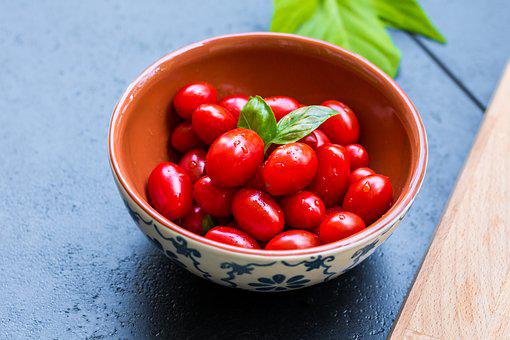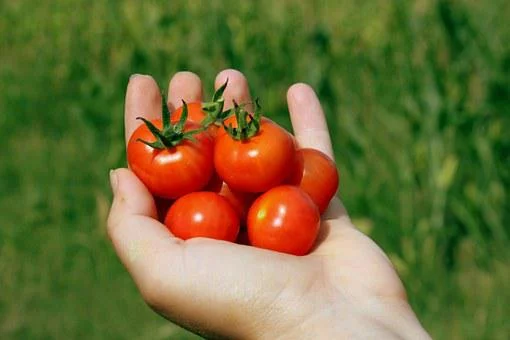Grape tomatoes are small enough to pop in your mouth, add to salads, or put into your favorite pasta recipe. However, it can be a bit hard to tell how many calories are in grape tomatoes.
While grape tomatoes are nutritious, tasty, and nourishing, their calories differ from other types of tomatoes. These tomatoes are low in calories and carbs while providing numerous important nutrients to your body.
Grape tomatoes are also high in fiber and antioxidants, which keep you healthy. Keep reading to learn more about the number of calories in grape tomatoes. Grape tomatoes are also high in fiber and antioxidants, which keep you healthy. Keep reading to learn more about the number of calories in grape tomatoes.
What are Grape Tomatoes?
Grape tomatoes have a more oblong, oval-like form, similar to a grape. The tomatoes have a thicker, meatier, and chewier texture than cherry tomatoes. However, they're not as sweet and delicately flavored as cherry tomatoes, but the flavor might vary from batch to batch.
With the best fertilizer for tomatoes, grape tomato plants grow at a similar rate as regular tomato plants. However, it takes less time for the little fruit to mature and ripen. The fruit should start to mature approximately 70 days after you plant the tomato.
They are great for salads, tomato sauce, kebabs, and roasting. These tomatoes have one advantage: they have a somewhat longer shelf life than cherry tomatoes owing to their slightly harder skin.

Grape tomatoes are best kept at room temperature, away from direct sunlight, or in a plastic clamshell or paper bag in the refrigerator crisper. Tomatoes may be refrigerated for up to 5 days, although the taste is best if used within the first three days.
Nutrition Facts: Calories in Grape Tomatoes
One grape tomato has around 5 calories. Therefore, a 1-cup serving of grape tomatoes (approximately five or six slices) has 25 to 30 calories.
Grape tomato plants contain almost all of their calories from carbs, although they also include trace quantities of fat and protein. Each tomato has less than one calorie from these two macronutrients.
Other Nutrition Facts
For a Serving Size of 1 cup of grape tomatoes (149g), here are the nutrition facts with % Daily Value;
- Total Fat 0.3g - 0%
- Saturated fat 0g - 0%
- Monounsaturated fat 0g -0%
- Polyunsaturated fat 0.1g -0%
- Sodium 7.5mg- 1%
- Potassium 353.1mg- 8%
- Carbohydrates 5.8g- 0%
- Net carbs 4g- 0%
- Sugar 3.9g- 0%
- Fiber 1.8g- 8%
- Glucose 1.9g- 0%
- Fructose 2g- 0%
- Protein 1.3g- 0%
Vitamins and Minerals
- Vitamin A 62.6μg- 7%
- Vitamin A IU 1241.2IU- 0%
- Vitamin B6 0.1mg- 10%
- Vitamin B12 0μg- 0%
- Vitamin C 20.4mg- 35%
- Vitamin D 0μg- 0%
- Vitamin D IU 0IU- 0%
- Vitamin E 0.8mg- 5%
- Vitamin K 11.8μg- 10%
- Caffeine 0mg- 0%
- Calcium 14.9mg- 2%
- Iron 0.4mg- 6%
- Magnesium 16.4mg- 5%
- Phosphorus 35.8mg- 4%
- Zinc 0.3mg- 2%
- Copper 0.1mg- 5%
- Fluoride 3.4μg- 0%
- Manganese 0.2mg- 9%
- Selenium 0μg- 0%
- Retinol 0μg- 0%
- Lycopene 3833.8μg- 0%
- Thiamine 0.1mg- 4%
- Riboflavin 0mg- 2%
- Niacin 0.9mg- 5%
- Folate 22.4μg- 6%
- Choline 10mg- 2%
- Betaine 0.1mg- 0%
- Water 140.8g- 0%
- Fatty acids- 0%
- Amino acids- 0%
* The % Daily Value (DV) shows you how much a nutrient in the food contributes to your daily diet. The Percent Daily Value is based on a 2,000 calorie general nutrition advice, so the values may differ based on your calorie needs.
1. Carbohydrates
Grape tomatoes contain slightly more than one gram of carbohydrates per tomato. Carbohydrates are a required component of your diet. Your digestive tract will break down the carbohydrate to convert it into a simpler molecule known as glucose.
Glucose is the primary fuel source for most cells, including brain cells. According to the Centers for Disease Control and Prevention, carbohydrates should account for 45 to 65 percent of your daily calories. Since carbohydrates give 4 calories per gram, a 1,800-calorie diet requires 202 to 293 grams of carbs each day.
2. Lycopene
Tomatoes have a high concentration of lycopene, a form of vitamin A molecule. Lycopene functions as an antioxidant, which means it neutralizes dangerous free radicals that injure healthy cells. Free radicals raise your chances of developing heart disease, cancer, and other chronic illnesses.
Lycopene from tomatoes minimizes oxidative stress in the body, hence lowering damage to genes and cells. This advantage may reduce your chances of developing a chronic condition.
3. Fiber
Grape tomatoes provide approximately.5 grams of total fiber per tomato. Fiber is a critical component of your diet. It aids in regularity by helping your digestive system to expel waste. The soft core of tomatoes contains soluble fiber, but the rough outer shell has more insoluble fiber.
Soluble fiber helps slow digestion and keeps you feeling fuller for longer. Insoluble fiber sweeps through your stomach like a broom, helping the formation of soft, thick stools.
You should take 14 grams of fiber for every 1,000 calories consumed for best gut health. A daily fiber intake of about 25 grams is required for a 1,800-calorie diet.
Cherry Vs. Grape Tomatoes
It's no wonder that many people can't differentiate a Cherry Tomato from a Grape Tomato since both are tiny and delicious. However, there are some differences between these tasty and versatile tomatoes, you have to know what to look for!

This section will explain the differences between Cherry Tomatoes and Grape Tomatoes based on the facts about each tomato.
1. Calories
Grape tomato has 50% more calories than a cherry tomato.
2. Carbohydrates
Grape tomato has 41% more carbohydrates than a cherry tomato.
3. Dietary Fiber
Grape tomato has 75% more fiber than a cherry tomato.
4. Water
Cherry tomato has 2% more water than grape tomato.
5. Vitamins
- Vitaminium B1 (Thiamine): grape is 17% more than a cherry tomato
- Vitaminium B2 (riboflavin): grape is 55% more than a cherry tomato
- Vitaminium B3 (Niacin): cherry is 24% more than grape tomato
- Vitaminium B6: cherry is 150% more than grape tomato
- Vitaminium C: grape is 18% more than a cherry tomato
- Vitaminium E: cherry is 24% more than grape tomato
6. Minerals
- Calcium: grape has 22% more than a cherry tomato
- Iron: cherry has 52% more than grape tomato
- Magnesium: grape has 49% more than a cherry tomato
- Phosphorus: cherry has 400% more than grape tomato
- Potassium: cherry has 8% more than grape tomato
- Sodium: cherry has 33% more than grape tomato
- Zink: grape has 1515% more than a cherry tomato
Frequently Asked Questions on Grape Tomatoes
1. How many calories are 7 grape tomatoes?
There are about 25-35 calories available in 7 grape tomatoes.
2. How many calories is one cup of grape tomatoes?
One cup, about 149 grams, has approximately 25 to 30 calories.
3. Are grape tomatoes good for weight loss?
Yes. They're an excellent source of fiber, particularly when the skin is left on, providing around 7% of the daily requirement. In fact, since cherry tomatoes are high in fiber and low in calories, they may aid in weight loss by ensuring you stay full and hydrated.













